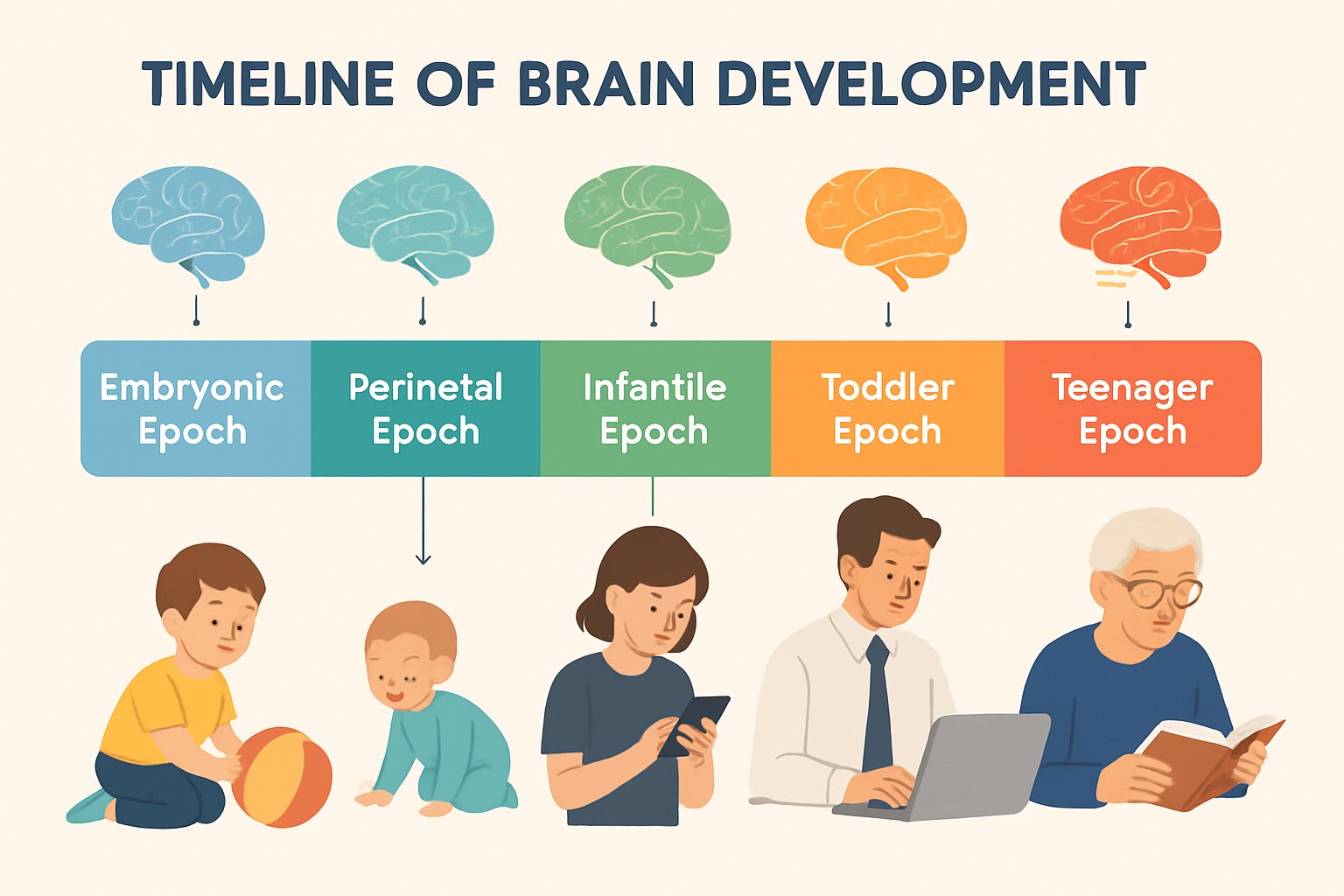
AI CERTS
1 day ago
Neuroscience Reveals Five Brain Wiring Epochs
Moreover, the team used manifold learning to integrate twelve graph metrics into a holistic developmental picture. This article unpacks the findings, methods, and business relevance for data-driven health innovators. Neuroscience now offers a clearer roadmap for timing interventions and understanding vulnerability windows. In contrast, earlier studies focused on single metrics or narrow age bands. Therefore, industry leaders should understand why the new lifespan approach matters. The following sections provide concise analysis, practical implications, and links to advanced certification pathways.
Mapping Brain Wiring Epochs
Cambridge scientists describe five distinct epochs stretching from infancy to late adulthood. Furthermore, each epoch exhibits unique patterns of Neural Wiring integration and segregation. The authors label population turning points at roughly nine, 32, 66, and 83 years. Consequently, developmental neuroscience gains a quantitative scaffold that contextualizes behavioral milestones. External experts applaud the wide age coverage, yet caution against viewing the ages as rigid boundaries. These insights bridge lab research with clinical timelines. However, individual variability remains considerable. These findings frame every later discussion.

These observations highlight a fresh layer of temporal structure. Nevertheless, more granular longitudinal evidence will strengthen causal claims. The next section explains the methodological rigor supporting the claims.
Neuroscience Context Significance Insights
The study reshapes how Cognitive Development is plotted across decades. Additionally, it informs educational, clinical, and workplace policies that align with brain plasticity peaks. Lifespan inequalities, mental-health risks, and skill-acquisition windows can now be tracked against biological change. Moreover, the work reinforces a broader shift in Neuroscience toward network-level analysis rather than isolated regions. In contrast, classical neuropsychology relied on lesion and behavior correlations. Consequently, interdisciplinary teams in public health and product design should incorporate network dashboards when planning age-specific solutions.
These contextual gains deepen the field’s relevance. Subsequently, professionals need to grasp the technical underpinnings to evaluate robustness.
Multi-Dataset Research Methods Rigour
Robustness stems from combining nine open cohorts, harmonized with ComBat correction. Moreover, deterministic tractography extracted five million streamlines per participant, reducing sampling noise. The team computed twelve complementary graph metrics before dimensionality reduction. Subsequently, 968 UMAP projections revealed stable manifolds where age gradients flipped direction.
- Lifespan Study sample size: 3,802 neurotypical scans
- Age range: 0–90 years, balanced across sexes
- Turning-point detection: 5th-degree polynomial inflection filtering within five-year windows
- Density controls: 10% threshold networks versus natural density networks
Consequently, methodological triangulation limited false discoveries. Nevertheless, diffusion MRI still infers rather than directly measures wiring. These technical choices underpin confidence in headline ages. However, understanding the numbers alone is insufficient without examining practical meaning.
Key Turning Point Ages
The strongest shift occurs at 32, when global efficiency peaks and modular segregation begins declining. Furthermore, the nine-year mark shows rising small-worldness as primary sensory systems stabilize. In contrast, the 66-year point reveals accelerated clustering loss, suggesting emerging vulnerability to disconnection. Meanwhile, the final turning point, 83, coincides with steep drops in subgraph centrality, although sample size there was modest.
These turning points intersect with critical Cognitive Development phases. Moreover, they suggest optimal intervention periods for language, executive function, and healthy ageing programs. Consequently, policymakers can align resource allocation with biological reality. These age markers also aid developers designing adaptive learning technologies that respect neural readiness.
Such chronological anchors clarify lifelong trajectories. Nevertheless, population averages never dictate individual fate, a theme explored next.
Implications For Cognitive Health
Healthcare strategists now hold a timetable for preventive screening. Additionally, mental-health services can heighten surveillance around the nine-year shift when anxiety disorders often emerge. Employers may leverage mid-life plasticity at 32 to re-skill workforces, enhancing Neural Wiring resilience. Moreover, start-ups building digital therapeutics can sync release cycles with predicted engagement peaks. Consequently, the research widens commercial and societal opportunities.
Professionals can enhance their expertise with the AI+ Developer™ certification. This credential strengthens data interpretation skills essential for modern Neuroscience ventures.
These applied vistas expand competitive advantage. However, responsible deployment demands awareness of study caveats.
Limitations And Future Work
Cross-sectional design limits causal inference across the entire Lifespan Study. Additionally, diffusion MRI tractography can generate false positives in complex fiber crossings. Nevertheless, harmonization and sensitivity tests mitigate some bias. Sample scarcity above 83 years reduces statistical power, urging targeted recruitment. Moreover, culture-specific factors may shift turning points, demanding global replication.
Upcoming longitudinal projects will refine timing precision. Consequently, collaboration between basic scientists and industry will accelerate translational gains.
These constraints temper over-interpretation. Subsequently, the article concludes with actionable guidance.
Practical Takeaways For Professionals
Executives, clinicians, and researchers should integrate five core lessons:
- Align product roadmaps with identified turning points for peak engagement.
- Embed network metrics, not single regions, within analytics dashboards.
- Prioritize mid-life upskilling programs around the 32-year efficiency apex.
- Boost late-life connectivity through social and cognitive enrichment strategies.
- Support longitudinal data sharing to close current evidence gaps.
Moreover, mastering graph analytics strengthens strategic decision-making across tech and health verticals. Neuroscience insights now translate directly into return-on-investment forecasts.
These distilled directives empower timely action. Consequently, continued education remains essential.
Neuroscience research has mapped five wiring epochs, spotlighted four turning ages, and delivered new lenses on Cognitive Development. Furthermore, multi-dataset rigor and manifold analytics bolster confidence despite recognised caveats. Additionally, cross-sector innovators can harness the findings to time interventions, develop adaptive products, and refine talent strategies. Nevertheless, future longitudinal work will sharpen individual forecasts. Therefore, explore the referenced study and pursue certifications to stay ahead in the rapidly evolving brain economy.



